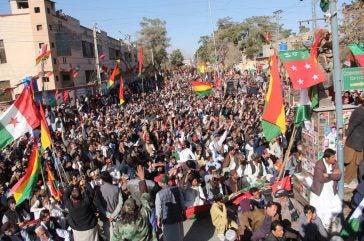
Pakistan’s new government presidency followed a split mandate given by the voters to contesting political parties and independents in the 8 February elections.
The government-building negotiations with the Pakistan People’s Party (PPP) was conducted amid allegations and counter allegations regarding rigging in the polls. Political instability has been heightened by the jailing of former Prime Minister Imran Khan, who is supported by the largest bloc in the new parliament – made of independents backed by his party Pakistan Tehreek-e-Insaf (PTI).
This weak government, likely to command a narrow parliamentary majority, will have to face multiple economic problems, such as a rising trade deficit, high energy costs, inflation (28.3% in January) and International Monetary Fund (IMF) pressure to withdraw consumer goods subsidies. This has come in negotiations to seek an extension to Pakistan’s IMF $3bn financing deal, ending in March (2024). The Federation of Pakistan Chamber of Commerce & Industry (FPCCI) and the All Pakistan Textile Mills Association (APTMA) told Just Style this will be the biggest early challenge for the new government.
Meanwhile, the new government will need to make the Pakistan clothing and textile export industry more viable, given it has been under a heavy financial burden of increasing costs, because of rising energy tariffs, said Zaki Ijaz, FPCCI regional chairman.
“During 2023 the government, under IMF pressure, increased the gas tariff for the captive power plants by up to 210%, resulting in the closure of 160 out of total 400 captive power plants of textile mills,” he told Just Style. Furthermore, he said, the Pakistan clothing and textile industry wants the government to half the current power tariff – to Pakistan Rupees PKR25 ($0.09) per kWh from PKR50 ($0.18) per kWh, to reduce production costs.
If the government fails, clothing and textile exports will fall through reduced competitiveness, said Ijaz, halting a promising upward trend during the last two months. According to the Pakistan Bureau of Statistics, in January (2024), textile and clothing exports rose 10.10% to $1.45bn.

US Tariffs are shifting - will you react or anticipate?
Don’t let policy changes catch you off guard. Stay proactive with real-time data and expert analysis.
By GlobalDataIn the longer term, Kamran Arshad, north zone chairman of the APTMA said: “Pakistan is losing export share in the world market because of the alarming rise in energy tariffs.” He said Pakistan’s clothing and textile sector has an un-utilised export capacity of $600m per month, due to high energy costs: “I must say that only a rapid increase in exports is the solution to meet [Pakistan’s] $2bn per annum gross external financing requirements, otherwise the balance of payments will continue worsening, giving rise to unemployment.”
He argued that the Pakistan textile and clothing industry operates on low margins of 3-4%, and if the new government did not address the issue of high energy tariffs, it will become uncompetitive locally as well as internationally.
If the government rationalised energy tariffs and reduced the national base bank interest rate to 15% from 22%, it could achieve annual export revenue targets of $100bn for all kinds of overseas sales, including textiles and clothing in five to 10 years set by outgoing caretaker commerce minister Gohar Ejaz, also a former APTMA leader, said Ijaz.
“I would suggest to the new government which will hopefully be in place by the end of the month, to sign a charter of democracy taking on board all stakeholders [all political parties] for 10 years to ensure consistency in economic policies of the country,” said Ijaz. And more importantly, the government must ensure that energy tariffs are not increased again. Meanwhile, if the government could improve trade relations with neighbouring Iran and India, that would be a positive step – diplomatic links with both countries remain poor and sometimes hostile.
The result of that has been a reliance on good relations with China: “Depending solely on China is not a wise decision,” he argued, saying terms often favoured Chinese exporters and investors – better trade relations with both India and China would give Pakistan exporters more options.



